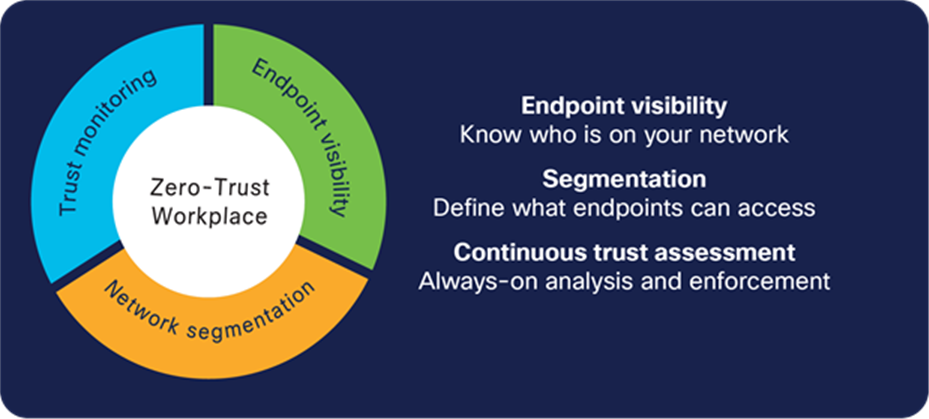Cisco Software-Defined Access At-a-Glance
Available Languages
Bias-Free Language
The documentation set for this product strives to use bias-free language. For the purposes of this documentation set, bias-free is defined as language that does not imply discrimination based on age, disability, gender, racial identity, ethnic identity, sexual orientation, socioeconomic status, and intersectionality. Exceptions may be present in the documentation due to language that is hardcoded in the user interfaces of the product software, language used based on RFP documentation, or language that is used by a referenced third-party product. Learn more about how Cisco is using Inclusive Language.
Securing your network in a complex world
As the number of users grows, the use of IoT devices increases, and cloud adoption rises, traditional networks are becoming more complex. This complexity is further increased when defining security policies for devices that can log in from various locations such as remote sites, offices, campuses, or branches on any given day. Coherent access policies are crucial for securing the network. Zero-trust access from anywhere requires consistent segmentation and access policies for users, devices, and application workloads, regardless of whether they are remote or on premises.
Cisco Software-Defined Access is a comprehensive approach toward securing the network
Cisco Software-Defined Access (SD-Access), designed for the Catalyst® infrastructure, addresses these challenges by simplifying and securing access for users and devices while mitigating the risks associated with unknown IoT devices. By defining and enforcing device and access policies through proper segmentation, SD-Access provides exceptional zero-trust access for IoT endpoints and user devices alike. SD-Access not only helps organizations mitigate the risks associated with unknown devices but also delivers a superior user experience across both wired and wireless networks.

Software-Defined Access provides a comprehensive approach towards securing the network while extending capabilities for the future.
How can IT benefit from Cisco SD-Access?
Cisco SD-Access empowers IT departments such as NetOps and SecOps to build more secure, efficient, and scalable networks, enhancing both operational capabilities and user satisfaction.
Operational simplicity
● Network simplification through automation: SD-Access simplifies the deployment and provisioning of network services. Tasks that traditionally required manual intervention, such as VLAN configuration and policy enforcement, are automated, reducing the potential for errors and speeding up deployment times.
● Unified wired/wireless policy: by unifying wired and wireless network management, SD-Access reduces the need for separate management tools and processes, streamlining operations and reducing the learning curve for network administrators.
● Scalability with ease: SD-Access is designed to scale easily, allowing organizations to expand their networks without significantly increasing complexity. The automation and centralized control make it easier to add new devices and services as needed.
Secure networking
● Identity-based network segmentation: SD-Access identifies, segments, and profiles new devices. This removes the need to manage the many underlying Layer-2 protocols, thus providing IT the ability to better manage the network.
● Automated IT and OT integration: By automating network segmentation, SD-Access reduces complexity and operational costs, which in turn enables seamless connectivity and data flow between IT and OT systems. This results in more efficient management and enhanced protection of critical industrial processes.
● Consistent multidomain policy enforcement: SD-Access enables security administrators to create consistent access and segmentation policies regardless of which domain they choose to enforce the policy. IT teams benefit by streamlining administrative tasks and reducing the complexity associated with maintaining separate policies for different domains.
Digital experience assurance
● Network-wide digital resiliency: SD-Access will detect, respond to, and mitigate security threats more effectively, helping to protect sensitive data and maintain the integrity of network operations and supporting overall business goals.
● Policy and trust analytics: user, device, and application experience is monitored and assured. Anomalies detected and proactively addressed for secured connectivity. This empowers IT departments to create a more secure, compliant, and efficient environment while fostering trust and satisfaction among users.
Cisco SD-Access is built upon the robust Cisco® Catalyst Center platform and leverages the security capabilities of Cisco Identity Services Engine and Secure Network Analytics as well as third-party identity and vulnerability management solutions. For more information, visit the Cisco SD-Access, Cisco Catalyst Center, and Cisco Identity and Service Engine pages. Or talk with your Cisco Sales or partner representative.